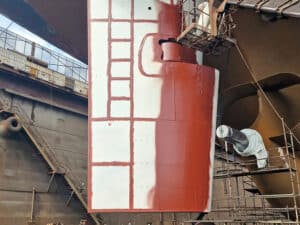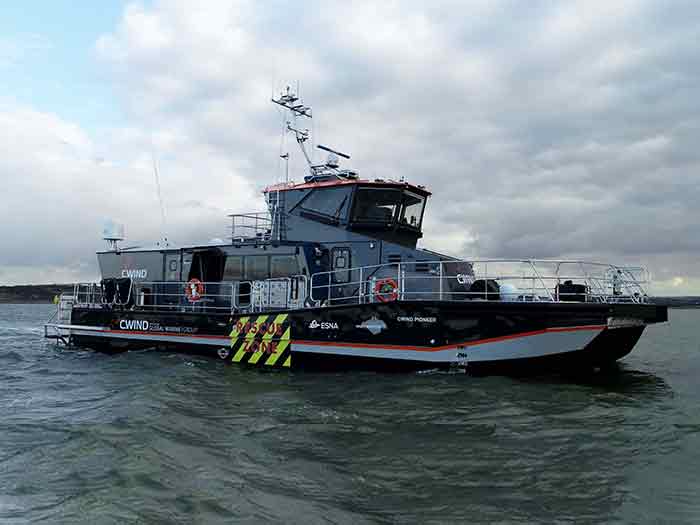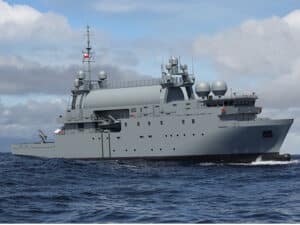
BV classes world’s first hybrid SES crew transfer vessel
Written by Nick Blenkey
CWind Pioneer at sea.
Bureau Veritas has classified the world’s first hybrid-powered surface effect ship (SES), the CWind Pioneer. Built at the U.K.’s Wight Shipyard, the 22 meter long x 8.9 meter beam crew transfer vessel features an air cushion, twin hulls and an innovative diesel and electric drivetrain with considerable battery storage onboard.
With a capacity of 24 passengers, the CWind Pioneer is a direct response to the needs of the offshore wind industry for both technologies that reduce CO2 emissions and for cost-effective services to wind farms located further offshore. The CWind Pioneer can operate at speeds exceeding 43 knots and can transfer personnel safely and comfortably even in extreme weather conditions with significant wave heights up to 2 meters, permitting greater operational windows.
Its air cushion motion control system provides significant advantages, with smoother and more comfortable conditions on-board and increased operational days offshore.
The CWind Pioneer is currently being used at the Borssele 1 and 2 offshore wind farms in the Netherlands.
The CWind Pioneer has a hybrid diesel and battery electric power system, which enables the vessel to operate purely on battery power alongside or at slow speeds, such as when transiting restricted waterways or on standby in the wind farm, which helps reduce fuel consumption, reduce [diesel] engine running hours and lower CO2 emissions.
This technology reduces engine wear and consequently maintenance costs. The reduced noise and vibration levels also provide greater comfort for offshore personnel, helping to ensure that they are fit for work when arriving at the offshore wind farms.
However, notes BV, implementation of the electric hybrid system comes with a good level of complexity that needs to be managed carefully. BV’s notation ‘”Electric-Hybrid” addresses that complexity, defining requirements for storage, power distribution, control and instrumentation, as well as tests that must be carried out relating to power management and critical safety considerations, such as thermal runaway.
As a leading training provider to the offshore wind industry, CWind has developed its own rigorous training course for operators of the CWind Pioneer, ensuring the crew has the skills necessary to manage the systems onboard.
Herman Spilker, VP North Europe for Bureau Veritas, commented: “Through the diversity of our fleet, Bureau Veritas has built high technical expertise which help support the development of the CWind Pioneer’s step-change design and eco-friendly operations. We are proud of this superb achievement and we wish its technicians and crew safe and comfortable sailing.”
“By working together with industry bodies, including Bureau Veritas, our clients, Ørsted, and a range of highly qualified naval architects, shipbuilders and marine engineers, including our in-house team, we have managed to achieve something truly exceptional,” says Nathanael Allison, Managing Director at CWind. “As the CWind Pioneer continues to perform well in-field, we will also be able to track a wealth of data to adapt and improve the performance of our hybrid vessels in the future.”
Bureau Veritas was involved with the project from its early design stages. Close cooperation with the designers, ESNA – a Norwegian naval architecture company, and Global Marine Group’s in-house Engineering Department and shipbuilders, Wight Shipyard Co., enabled Bureau Veritas experts to provide their technical and regulatory expertise. In order to ensure that CWind Pioneer can take full advantage of the electric hybrid technology in a safe manner, Bureau Veritas has assigned the notation Electric Hybrid (PM, ZE). This notation provides a comprehensive framework for the safe implementation of this technology while achieving the client’s objectives of working at zero-emission mode, at port or at standby in the offshore wind farm, as well as enhancing speed performance in boost mode to reduce transfer time between shore and the offshore wind farms.




